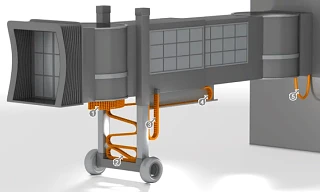Ubah Bahasa :
Jembatan keberangkatan penumpang
Tanpa jembatan ini, penerbangan akan menjadi jauh lebih tidak nyaman: jembatan naik penumpang (juga dikenal sebagai gangway atau jembatan naik penumpang) memungkinkan naiknya pesawat yang terlindungi dan sejajar di ribuan bandara di seluruh dunia. Pada masa-masa awal penerbangan, naik ke pesawat bahkan lebih mudah. Pesawat kecil yang digerakkan baling-baling memiliki anak tangga kecil yang dapat diturunkan dengan mudah. Bahkan saat ini, pesawat terbang yang lebih kecil umumnya menggunakan tangga built-in, karena kemiringan di jembatan naik penumpang akan terlalu curam.
Bagaimana jadinya tanpa jembatan naik penumpang? Pesawat komersial modern memiliki ketinggian naik ke pesawat hingga 4 meter di atas tanah. Pada pesawat jet raksasa seperti Airbus A380, penumpang bahkan harus naik ke atas dua tingkat. Diperlukan tangga yang sangat tinggi. Dan keluarga dengan anak-anak, penumpang lanjut usia dan penumpang yang lemah akan merasa lebih sulit untuk naik ke pesawat. Belum lagi perlindungan dari angin dan cuaca.

Prinsip jembatan naik penumpang sederhana: biasanya, satu bagian dari sistem ditambatkan dengan kuat ke bangunan bandara. Bagian lainnya dipasang secara fleksibel sehingga dapat merapat ke berbagai jenis pesawat. Misalnya, perbedaan ketinggian pintu pesawat serta panjang dan lebar pesawat yang berbeda perlu dikompensasi. Untuk tujuan ini, gangway biasanya terdiri dari beberapa tabung yang dapat teleskopik masuk dan keluar dan satu atau lebih unit pengangkat. Gangway teleskopik ini adalah varian gangway penumpang yang paling fleksibel. Desain yang kurang fleksibel sering kali hanya cocok untuk jenis pesawat tertentu, yang membatasi fleksibilitas operator bandara.
Jembatan naik penumpang digerakkan dengan bantuan motor listrik. Ini membutuhkan kabel daya dan data ke sistem kontrol. Pergerakan masing-masing elemen tidak terlalu cepat. Namun demikian, kabel-kabel tersebut harus dilindungi dari kerusakan. Karena biasanya terletak di luar gang, mereka juga harus tahan terhadap angin dan cuaca.
Keunggulan produk igus® pada jembatan naik penumpang
Karena waktu menganggur pesawat menjadi semakin singkat dan jembatan naik penumpang harus bekerja dengan andal, pergerakan mekanis harus berjalan dengan lancar. Jika jembatan naik penumpang terhenti, ini bisa berarti kerugian finansial langsung bagi operator bandara, maskapai penerbangan, dan juga bagi penumpang, yang ingin terbang dengan nyaman, aman, dan tepat waktu.
Keandalan yang tinggi dari produk igus® mendukung penggunaannya di jembatan keberangkatan penumpang. Pergerakan kabel di gangway dapat dipandu dengan aman dengan sistem rantai elektronik kami. Gerakannya sebagian besar adalah gerakan horizontal di terowongan teleskopik dan gerakan vertikal di unit pengangkat. Rantai elektronik® memiliki masa pakai yang lama, sehingga masa pakai yang lama dapat diharapkan. Mereka dapat dipasang dengan cara yang hemat ruang sehingga tidak ada kabel yang menggantung dan tampilan visual tidak terganggu. Semua energi yang diperlukan dapat dipasok dengan rantai elektronik®, misalnya kabel daya dan kontrol, hidraulik, pneumatik, dll.
1 sistem rantai elektronik gerakan putar sebagai solusiradius tikungan balik 2
Sistem rantai elektronik gerakan angkat - jenis instalasi
"
zig-zag " 3Sistem rantai elektronik gerakan pengangkatan -
jenis instalasi " ditangguhkan " 4 Sistem rantai elektronik gerakan horizontal - instalasi tipe tidak didukung atau geser 5 Perlindungan kabel di beberapa sumbu sistem rantai elektronik memandu dan melindungi dalam aplikasi bergerak, tiga dimensi
Sistem rantai elektronik mengurangi panjang kabel yang diperlukan hingga lebih dari 50% (dengan pemakanan sedang) dan mencegah beban mekanis eksternal pada kabel, seperti goyangan yang tidak terkendali, berayun, macet, dll. Persyaratan perawatan yang rendah mengurangi waktu henti. Sistem rantai elektronik bekerja secara ideal bersama dengan kabel igus® chainflex®. Sama seperti rantai elektronik®, mereka dapat menahan panas, matahari, hujan, dan salju.
Produk untuk digunakan di jembatan naik penumpang
rantai energi
Berhasil digunakan
Konsultasi
Saya akan dengan senang hati menjawab pertanyaan Anda secara langsung
PT igus® Indonesia+62 21 7588 1933Tulis e-mail
Pengiriman dan konsultasi
Secara pribadi:
Senin - Jumat dari jam 8.30 - 17.30 WIB
Online:
24 Jam
WhatsApp-Service:
Senin - Jumat dari jam 8.30 - 17.30 WIB



